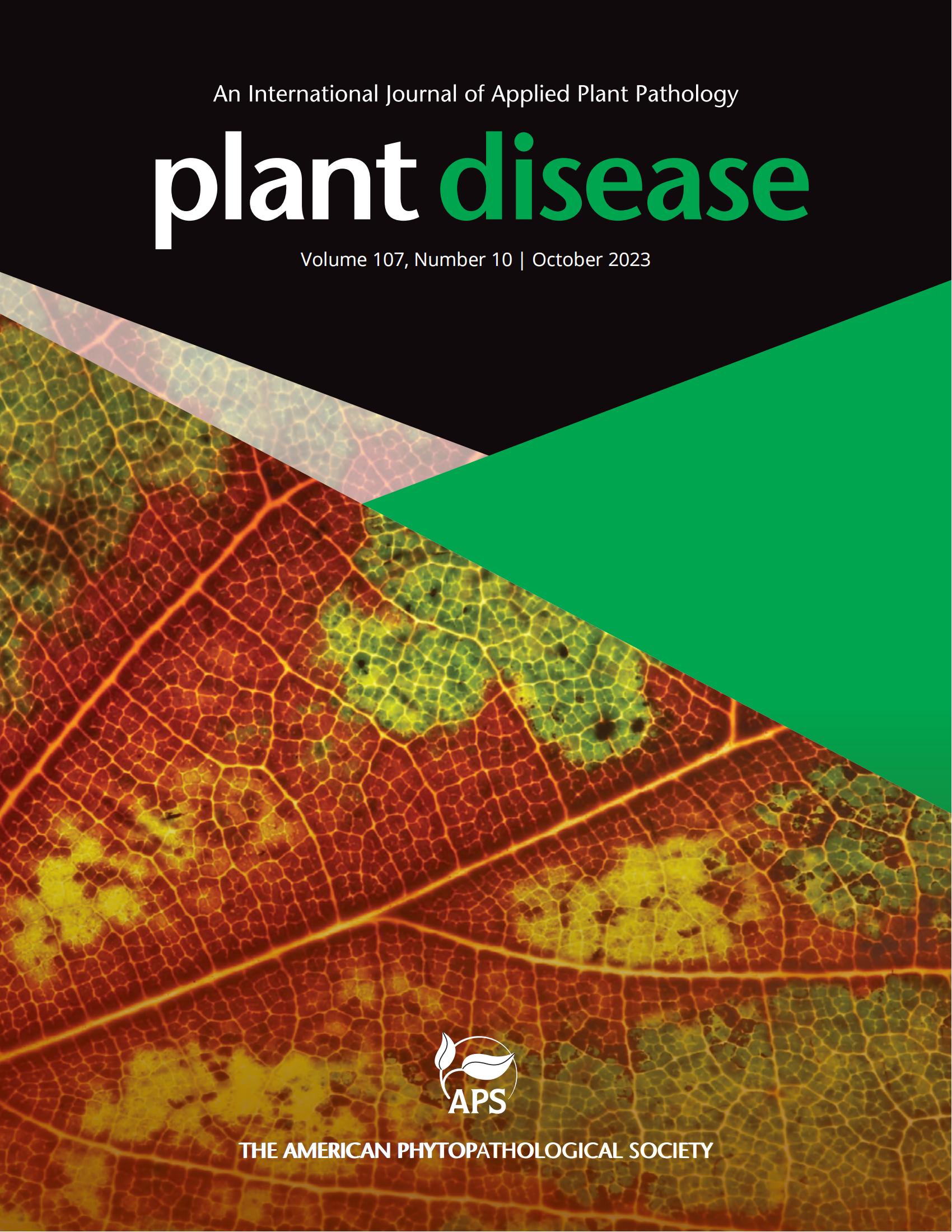求助PDF
{"title":"尽管杂草在覆盖作物上无症状定殖,但通过限制杂草生物量,覆盖耕作可减轻相思子巨霉菌的种群增长。","authors":"Clara Qin, Polly H Goldman, Jim Leap, Peter Montgomery Henry","doi":"10.1094/PDIS-05-24-0951-RE","DOIUrl":null,"url":null,"abstract":"<p><p><i>Macrophomina phaseolina</i> is a fungus that causes charcoal rot in strawberry and a wide variety of crop species. Little is known about its potential to asymptomatically colonize crop plants or grow saprophytically on their tissues, both of which would create a potential for alternate, asymptomatic hosts to lead to increases in inoculum. To test the impact of cover cropping on <i>M. phaseolina</i> abundance, we conducted randomized-block field experiments in soils infested by <i>M. phaseolina</i>. None of the 15 cover crop varieties showed symptoms of charcoal rot. All Fabaceae and Brassicaceae varieties were asymptomatically colonized at varying rates, but among Poaceae <i>M. phaseolina</i> was recovered from only one individual oat plant. Soil samples collected at the time of planting, tillage, and 8 weeks after tillage showed that cover cropping attenuated the growth of <i>M. phaseolina</i> relative to fallow plots harboring the weedy legume <i>Medicago polymorpha</i>. This weed species was abundantly colonized by this pathogen in both living root samples and plant residue collected 8 weeks after tillage. Cover cropping also influenced the diversity and composition of bulk soil bacterial and fungal communities, but these effects were not associated with <i>M. phaseolina</i> population density. Although <i>M. phaseolina</i> was not detected in living wheat tissues, it was recovered from wheat residue, suggesting that it may be facultatively saprophytic. These results suggest that cover cropping does not pose a risk for increasing disease caused by <i>M. phaseolina</i> and could be beneficial as conducive weed species, such as <i>M. polymorpha</i>, are suppressed.[Formula: see text] Copyright © 2025 The Author(s). This is an open access article distributed under the CC BY-NC-ND 4.0 International license.</p>","PeriodicalId":20063,"journal":{"name":"Plant disease","volume":" ","pages":"PDIS05240951RE"},"PeriodicalIF":4.4000,"publicationDate":"2025-02-17","publicationTypes":"Journal Article","fieldsOfStudy":null,"isOpenAccess":false,"openAccessPdf":"","citationCount":"0","resultStr":"{\"title\":\"Cover Cropping Attenuates Population Growth of <i>Macrophomina phaseolina</i> by Limiting Weed Biomass, Despite Asymptomatic Colonization of Cover Crops.\",\"authors\":\"Clara Qin, Polly H Goldman, Jim Leap, Peter Montgomery Henry\",\"doi\":\"10.1094/PDIS-05-24-0951-RE\",\"DOIUrl\":null,\"url\":null,\"abstract\":\"<p><p><i>Macrophomina phaseolina</i> is a fungus that causes charcoal rot in strawberry and a wide variety of crop species. Little is known about its potential to asymptomatically colonize crop plants or grow saprophytically on their tissues, both of which would create a potential for alternate, asymptomatic hosts to lead to increases in inoculum. To test the impact of cover cropping on <i>M. phaseolina</i> abundance, we conducted randomized-block field experiments in soils infested by <i>M. phaseolina</i>. None of the 15 cover crop varieties showed symptoms of charcoal rot. All Fabaceae and Brassicaceae varieties were asymptomatically colonized at varying rates, but among Poaceae <i>M. phaseolina</i> was recovered from only one individual oat plant. Soil samples collected at the time of planting, tillage, and 8 weeks after tillage showed that cover cropping attenuated the growth of <i>M. phaseolina</i> relative to fallow plots harboring the weedy legume <i>Medicago polymorpha</i>. This weed species was abundantly colonized by this pathogen in both living root samples and plant residue collected 8 weeks after tillage. Cover cropping also influenced the diversity and composition of bulk soil bacterial and fungal communities, but these effects were not associated with <i>M. phaseolina</i> population density. Although <i>M. phaseolina</i> was not detected in living wheat tissues, it was recovered from wheat residue, suggesting that it may be facultatively saprophytic. These results suggest that cover cropping does not pose a risk for increasing disease caused by <i>M. phaseolina</i> and could be beneficial as conducive weed species, such as <i>M. polymorpha</i>, are suppressed.[Formula: see text] Copyright © 2025 The Author(s). This is an open access article distributed under the CC BY-NC-ND 4.0 International license.</p>\",\"PeriodicalId\":20063,\"journal\":{\"name\":\"Plant disease\",\"volume\":\" \",\"pages\":\"PDIS05240951RE\"},\"PeriodicalIF\":4.4000,\"publicationDate\":\"2025-02-17\",\"publicationTypes\":\"Journal Article\",\"fieldsOfStudy\":null,\"isOpenAccess\":false,\"openAccessPdf\":\"\",\"citationCount\":\"0\",\"resultStr\":null,\"platform\":\"Semanticscholar\",\"paperid\":null,\"PeriodicalName\":\"Plant disease\",\"FirstCategoryId\":\"97\",\"ListUrlMain\":\"https://doi.org/10.1094/PDIS-05-24-0951-RE\",\"RegionNum\":2,\"RegionCategory\":\"农林科学\",\"ArticlePicture\":[],\"TitleCN\":null,\"AbstractTextCN\":null,\"PMCID\":null,\"EPubDate\":\"\",\"PubModel\":\"\",\"JCR\":\"Q1\",\"JCRName\":\"PLANT SCIENCES\",\"Score\":null,\"Total\":0}","platform":"Semanticscholar","paperid":null,"PeriodicalName":"Plant disease","FirstCategoryId":"97","ListUrlMain":"https://doi.org/10.1094/PDIS-05-24-0951-RE","RegionNum":2,"RegionCategory":"农林科学","ArticlePicture":[],"TitleCN":null,"AbstractTextCN":null,"PMCID":null,"EPubDate":"","PubModel":"","JCR":"Q1","JCRName":"PLANT SCIENCES","Score":null,"Total":0}
引用次数: 0
引用
批量引用

 求助内容:
求助内容: 应助结果提醒方式:
应助结果提醒方式:


